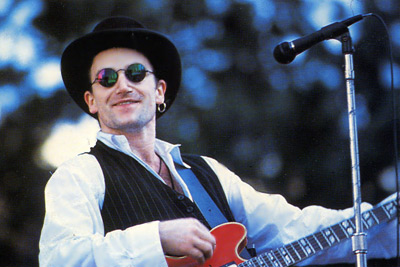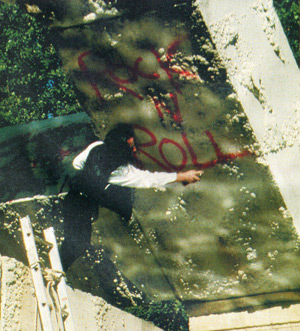
| Search JoyZine with Google Site Search! |
|
U2 interview by Frank Andrick
Then, while businessmen gazed in amazement from their skyscraper windows, the plaza reverberated with the sounds of amplified rock'n'roll and the answering roar of the 3-piece-suited crowd. Alternating moods of sunny frolic and respectful introspection, Bono extolled the 20,000 listeners to become involved in beneficial change, citing his own strife-torn Ireland as an example of Universal Application. U2 has always stressed individual responsibility and the freedom and power of sincere expression. U2's track record as a positive force in a largely negative world is well documented and almost irreproachable. The effect was undeniable as the chants of "No War, No More War" to the accompaniment of bombastic drumming and stridently strummed strains of "Sunday, Bloody Sunday" echoed from the concrete-and-glass walls of the high rises ringing the area. Always the music of rebellion and free expression, rock once again shook the status quo. Rather than laud the band for its good works and unimpeachable sentiments, the straight press took on the evil of rock'n'roll in a witch hunt reminiscent of its founding days when Chuck Berry, Little Richard and Elvis Presley were seen as emissaries of the Evil Empire. Rather than relating the positive aspects of U2's gift of free music to the residents of San Francisco, or the band's search for and expression of quality and freedom in life, or their rapport with 20,000 people who probably weren't normally fans, the media focussed on what they termed a "blatant act of vandalism" and "disrespect for the people of San Francisco."
Bono's reaction was one of stunned amazement. "We're the Batman and Robin of rock'n'roll! Have you guys ever picked on the wrong band! This doesn't make any sense!! This kind of politics and music don't mix. They are reacting to something they know nothing about. It's as if they feel they have to do something. Anything else we've done, are doing, or will continue to do, both as a band and as individuals, is being pushed aside." In other words, Bono feels that the officials are saying that all the good they do is of no value, and they are now being termed common criminals. "Somebody should explain to Mayor [Diane] Feinstein that there is a big difference between graffiti art and an act of vandalism," mused Bono. "I am an artist, not a vandal." He didn't sound angry or arrogant, but hurt. After all, Bono had not shown up under cover of night to do his dirty work and then sneak off, leaving the taxpayers to foot the cleanup bill. "We immediately paid for the alleged damages in good faith. They—Police Inspector Toomy and Mayor Diane Feinstein—are really making a mountain out of a molehill. 'An act of vandalism, malicious mischief,' they call it, as if to cover the importance of issues like South Africa, Nicaragua, the starving, the homeless, people devastated by war—and for reasons no one but a select and very sick few understand. In the light of these issues, we're taken to task for spray painting a slogan, a slogan whose removal we later paid for. A lot is getting lost in the shuffle and what's really important is getting ignored." In point of fact, this particular fountain has a long history of association with shaking the powers that be. The French-Canadian artist [of the fountain, Armand Vaillancourt] himself had scrawled "Quebec Libre" across the sculpture after cries of outrage had come from the artistic conservatives who hated its free-form expression. And it has been the frequent starting point for peace marches and protest rallies of the homeless (who every night swarm over the financial district, digging through the rich man's garbage for food). And it was then, in the spirit of artists united in their vision for a saner world, that Armand Vaillancourt flew to Oakland, California from his home in Quebec to show his support for U2. Appearing on stage in front of the sold-out, 60,000-seat stadium, Monsieur Vaillancourt cried out in his heavily-accented English, "Bono does not have to apologize to me. They are a band of social consciousness, and we have to support that." With a little help from each of the members of U2, he then painted "Stop the Madness, No More War" across U2's giant backdrop. Later, backstage, M. Vaillancourt added fuel to the controversy and expanded on his reasons for support of Bono's actions. "Bono and I, we are artists. We understand each other, and we understand the importance of the message. San Francisco is doing an injustice to its own people by doing this. Anyone who can think, who can feel, knows here in their hearts, it was the right thing to do. That is why I also came here tonight from Montreal, because it is the right thing to do. Stop the madness, stop the traffic, stop the killing... It is our responsibility as artists. Perhaps we can do no more, but we should never do less!" And out of all this will come a movie. A four-man film crew had gone along for the U.S. tour. Paid for by the band itself, in order to assure artistic integrity and control, the movie will avoid the filming clichés and overblown ego massaging of most rock epics, presenting instead a documentary look at a band at work. The band that continues to make a difference has to do this their own way, too. But is there any other way for U2? Blond and black-leather-clad drummer, Larry Mullen, Jr. tells us a little more about the film and U2's reasons for doing it themselves. "We had so many offers to do movies, but we had to do it ourselves. We have shot various concert sites throughout the tour. The cameras are available all the time, so it gives us the opportunity to capture things that normally slip by. A lot of the stage filming is different, it's not panning up to the band or looking down on the crowd. It's eye contact so we all know who we are, so you can see right in. I've already seen some of the footage—the rushes, they call them—and it's amazing. Putting it all together will be a challenge. We learn in the process by not being afraid to fall down. We don't really know how the film will be edited and what we'll add because we're still on tour and have road filming to do... and, of course, the finale is in Arizona, Joshua tree country, where this whole thing started!" So if you missed them live, you will still be able to get a front row seat and judge for yourself. Is Bono an artist or a vandal? It's your turn to speak up now: Stop the madness, or stop rock and roll? |

